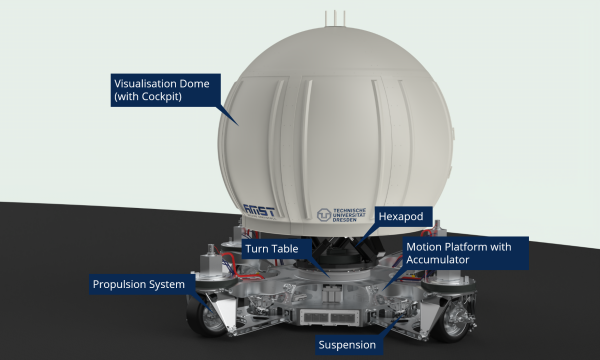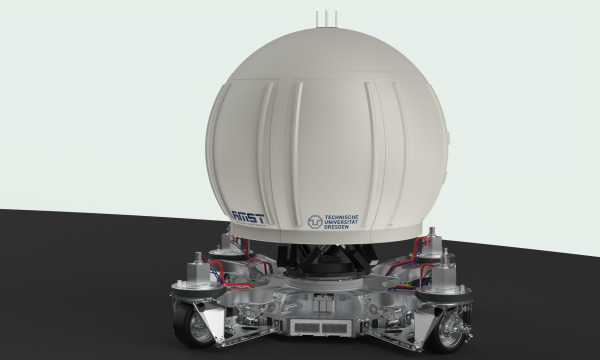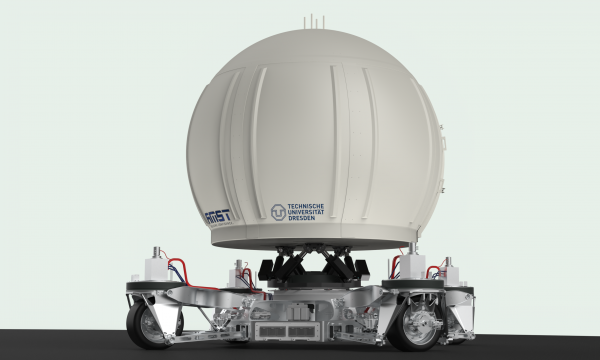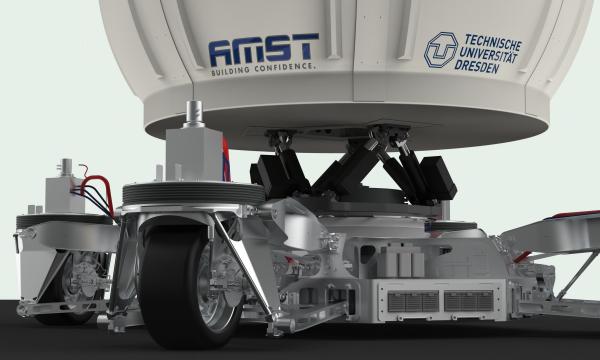
You are here
Chair of Automobile Engineering
TU Dresden develops worldwide unique highly immersive driving simulator for scenario-based testing of automated driving functions.
Get in the car, lean back and let yourself be taken from A to B. We are talking about (partially) automated driving. Around the world, the automotive industry and its research partners are working on new technologies and functions for the automated vehicle of the future. For a long time, the focus was only on technical progress. But the more autonomous the machines become, the more sustainable the role of the drivers will change. This brings another aspect into focus: humans and their interaction with automated vehicles and vehicle functions. In human-machine interaction, high technology meets human feelings and instinctive action. So what is needed to ensure that this human-machine interaction functions as efficiently, cooperatively and unambiguously as possible in the future in handover situations between the automated vehicle and the drivers – in everyday traffic, but especially also in critical situations and accident scenarios?
Highly immersive: Virtual world becomes (perceived) realistic driving scenario
This is where the new and technically unique self-driving highly immersive driving simulator of the Technische Universität Dresden (TU Dresden) comes in. Its innovative concept enables completely new and highly realistic simulation scenarios and thus, for the first time, a realistic perception of vehicle behaviour by the test drivers. Inside, the drivers are placed in realistic driving situations, including the sensation of acceleration and change of direction. The term "highly immersive", which comes from the field of virtual reality, refers to the technical "immersion" of the users in virtual reality, so that their consciousness perceives it as real. This is something that previous driving simulators can only offer for limited manoeuvres.
The great importance of the project for the further development of automated driving is also reflected in the millions in funding from the German Federal Ministry of Transport and Digital Infrastructure (BMVI). Federal Minister Andreas Scheuer: "With our new law on autonomous driving, we have already taken a giant step towards the future: for the first time, we can put self-driving vehicles on the road quite regularly - as the first country worldwide. With this, we are setting international standards. But research is also moving forward: the driving simulator at TU Dresden enables a completely new, realistic experience of driving manoeuvres. This makes it possible to test and improve handover situations between man and machine in a lifelike manner - especially in critical situations or even accidents. The 7 million euros that the BMVI is investing here are money well spent."
In order to obtain realistic reactions from the drivers and to draw conclusions for the interaction between man and machine, the simulator must generate a high immersion sensation. The information from the realistic replication of driving manoeuvres in safety-critical driving situations flows into the further development of technology and safety of autonomous driving functions. "By providing realistic perception of vehicle behaviour for the first time, the new driving simulator will revolutionise the development of automated vehicles," says Prof. Dr.-Ing. Günther Prokop, Head of the Chair of Automobile Engineering at the "Friedrich List" Faculty of Transport and Traffic Sciences at TU Dresden, confidently. He and his team are developing the high-tech vehicle in cooperation with AMST-Systemtechnik GmbH from Austria. Another partner and requirements provider is FSD Fahrzeugsystemdaten GmbH from Dresden. In addition, Porsche AG, as a cooperation partner of TU Dresden, is supporting the project with a vehicle cockpit for the highly immersive driving simulator. On 17 September 2021, representatives of Porsche AG handed over the cockpit to Prof. Prokop and his team - another important milestone for the project.
Project phases: Commissioning in Dresden from May 2022
Work on the innovative vehicle, whose design is unique worldwide, began in January 2019. The simulator is currently taking on its physical form at AMST - in other words, the individual parts are being built and assembled, and components from other project partners are being integrated. The plan is for it to arrive in Dresden in spring 2022. "And then the exciting phase of commissioning will begin," reports Dr. Thomas Tüschen, project manager and research assistant at the Chair of Automobile Engineering at TU Dresden. Even though the assembled vehicle will be in front of the project team in Dresden in May 2022, it will still take a few months before the first test persons are allowed to climb into the cockpit. "During commissioning, we still have to carry out numerous tests and adjustments. Only when everything is safe will the test persons join us," says Tüschen.
On tyres instead of rails - a simple idea with a big effect
If you compare the images of the 5x5x5 metre driving simulator of the TU Dresden with other driving simulators around the world, you will notice the tyres and different axes of movement. The wheels allow the driving simulator to move in all directions on a movement area of 70x70 metres in appropriate dry weather conditions. Herbert Pinwinkler, project manager on the AMST side, explains: "The driving simulator, with its 10 degrees of freedom of movement, moves freely on the plane and, unlike most other simulators, is not a tethered system mounted on rails." He emphasises what is important in the highly immersive driving simulator: "Sophisticated as well as high-performance lightweight design and motion control combined with a realistic virtual out-the-window view are intended to convey sensory impressions that are indistinguishable from those in the vehicle. This allows the driver to be completely immersed in the simulation."
According to Herbert Pinwinkler, the development and production of the driving simulator is a highlight in AMST's company history: "The project is a challenge that we gladly accepted. It gives us the opportunity to transfer and further develop our know-how in the simulation of aircraft to road vehicles."
Realistic skid and accident scenarios for safe driving automation functions
The innovative system opens up completely new fields of application for driving simulation: "The low moving masses of the system make it possible to simulate very dynamic manoeuvres, including skidding, without distorting the perception of the test persons. Accident development mechanisms can be researched in a highly realistic way in a safe environment and the effect of driver assistance systems can be optimised for accident avoidance or mitigation," explains Thomas Tüschen.
Due to the high dynamics of the system, the time span between "loss-of-control", "point-of-no-return" and "t0" (first moment of impact) can also be realistically simulated in the accident run-in. The human factor is crucial in such scenarios. "With our highly immersive driving simulator, we can now investigate this in a very real way and design the human-machine interface methodically and systematically," says Prof. Günther Prokop, referring to the importance of the project: "In development, a powerful tool for safeguarding driving automation functions is being created. On the research side, the highly immersive driving simulator will advance the further development of human behaviour models. In terms of driving dynamics, ride comfort and drivability, the Dresden driving simulator will open up new possibilities for assessing how the vehicle will 'feel' at a very early stage on the basis of objective benchmarks."
Facts project
PROJECT VOLUME: just under 12 million euros, of which 7 million euros in funding from the German Federal Ministry of Transport and Digital Infrastructure (BMVI)
TECHNICAL DATA:
- Dimensions: 5x5x5 metres
- Movement area of 70x70 metres with a moving mass of approx. 4,500 kg
- Acceleration of 10 m/s² (comparable to full braking)
- 10 degrees of freedom of movement
- Highly variable, freely controllable vehicle mock-up
- 220° projection screen
- Transportable, mobile system
APPLICATIONS:
- Development/ safeguarding of automated and assisted driving
- Objectification of driving dynamics and comfort
- Human-machine interaction
- Motion perception research
- Medical/psychological examinations (professional) drivers
Highly Immersive Driving Simulator
Projekt contact at TU Dresden
Dipl.-Ing. Stefan Plaettner
Research Associate, Chair of Automobile Engineering
"Friedrich List" Faculty of Transport and Traffic Sciences, TU Dresden
Mail: stefan.plaettner@tu-dresden.de
In development, a powerful tool for safeguarding driving automation functions is being created. On the research side, the highly immersive driving simulator will advance the further development of human behaviour models. In terms of driving dynamics, ride comfort and drivability, the Dresden driving simulator will open up new possibilities for assessing how the vehicle will 'feel' at a very early stage on the basis of objective benchmarks.




